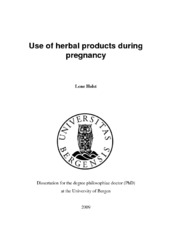Use of herbal products during pregnancy
Doctoral thesis
Permanent lenke
https://hdl.handle.net/1956/3702Utgivelsesdato
2009-05-27Metadata
Vis full innførselSamlinger
- Department of Chemistry [433]
Sammendrag
Background: The use of herbal remedies is gaining popularity in the western world though little scientific documentation for safety and efficacy is available. Women are found to be more frequent users of herbs than men and studies from North America, Australia and Europe have shown widespread use among pregnant women. Objective: The major aim of the work was to study use of herbal remedies during pregnancy in two different populations and by different methods. Methods: One study was performed as a survey among 578 pregnant women at the Norfolk and Norwich University Hospital between November 2007 and February 2008. Use of herbal remedies and treatment of various ailments were studied. Six women from this study population also participated in a focus group discussion about the results of the survey and their reasons for herb use in pregnancy. Another study was performed in the Swedish Medical Birth Register. Data on the use of herbal remedies during pregnancy were obtained from 860215 pregnant women during the period 1st July 1995 to end of 2004. Outcome variables studied were prematurity, birth weight, Apgar score, number of infants in delivery and congenital malformations. Results: The usage of herbal remedies during pregnancy was 57.8% in the UK study and 0.9% in the Swedish study. This very big difference is probably mainly due to the different methods of data collection. Ginger, cranberry and raspberry leaf were the most commonly used herbal remedies in the UK study while Floradix®, ginseng and valerian were most commonly reported in the Swedish study. Family and friends were the most used source of information about herbs used in pregnancy in the UK study and 75% of the herb users did not inform their doctor or midwife about the herb use. Potentially harmful herbs or herbs for which the documentation for safety in pregnancy is inadequate were used by 41.2% of the participants. Forty one different herbs were reported used and 96 different indications were given for the use but 46 of those indications could not be confirmed in literature as “traditional use”. The focus group discussion showed that users of herbal remedies expected health care personnel to disapprove of herb use and thus did not reveal use to them. They found it difficult to find a reputable alternative practitioner but they wanted the National Health Services to include alternative therapists in the public healthcare system. Conclusion: Use of herbal remedies is common among pregnant women while documentation of safety and efficacy is limited. Health care personnel should be able to give evidence based information about herbs but more research is necessary to enable this.
Består av
Paper I: Pharmacoepidemiology and Drug Safety 2008 17(2), Holst, L.; Nordeng, H.; Haavik, S., Use of herbal drugs during early pregnancy in relation to maternal characteristics and pregnancy outcome, pp. 151-159. Copyright 2007 John Wiley & Sons, Ltd. Full text not available in BORA due to publisher restrictions. The published version is available at: http://dx.doi.org/10.1002/pds.1527Paper II: The Journal of Alternative and Complementary Medicine 15(7), Holst, L.; Wright, D.; Haavik, S.; Nordeng, H., The use and the user of herbal remedies during pregnancy, pp. 787-792. Copyright 2009 Mary Ann Liebert, Inc. Full text not available in BORA due to publisher restrictions. The published version is available at: http://dx.doi.org/10.1089/acm.2008.0467
Paper III: Midwifery 27(1), Holst, L.; Wright, D.; Haavik, S.; Nordeng, H., Safety and efficacy of herbal remedies in obstetrics – review and clinical implications, pp. 80-86. Copyright 2009 Elsevier Ltd. Full text not available in BORA due to publisher restrictions. The published version is available at: http://dx.doi.org/10.1016/j.midw.2009.05.010
Paper IV: Complementary Therapies in Clinical Practice 15(4), Holst, L.; Wright, D.; Nordeng, H.; Haavik, S., Use of herbal preparations during pregnancy: Focus group discussion among expectant mothers attending a hospital antenatal clinic in Norwich, UK, pp. 225-229. Copyright 2009 Elsevier Ltd. Full text not available in BORA due to publisher restrictions. The published version is available at: http://dx.doi.org/10.1016/j.ctcp.2009.04.001
Paper V: Complementary Therapies in Clinical Practice 15(4), Holst, L.; Haavik, S.; Nordeng, H., Raspberry leaf – should it be recommended to pregnant women?, pp. 204-208. Copyright 2009 Elsevier Ltd. Full text not available in BORA due to publisher restrictions. The published version is available at: http://dx.doi.org/10.1016/j.ctcp.2009.05.003
